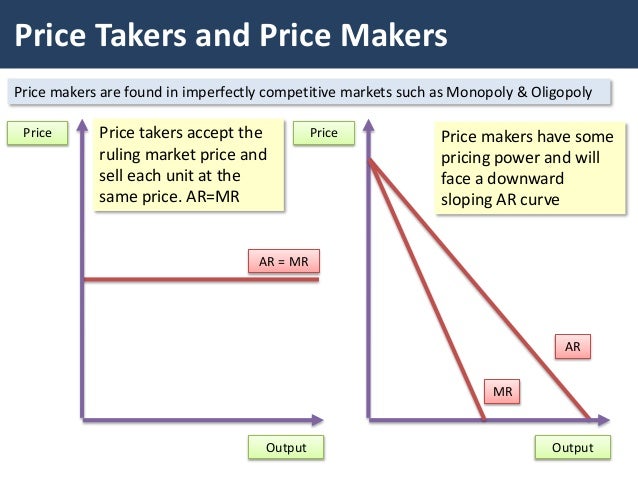
Microeconomics
3C. (Step 1) Maximize Total Revenue (TR) for any given output (Q)
a. Total Revenue (TR) and Marginal Revenue (MR)
- Total Revenue = (The price of a good or service)
(Quantity sold)
- Marginal Revenue = The change in total revenue
generated by an additional unit of output
b. Relationship to elasticity and Marginal Revenue (MR)
- The individual firm faces a horizontal, perfectly
elastic demand curve for its output – an individual demand curve for its
output that is equivalent to its marginal revenue curve.
c. Firm’s demand curve = Demand curve for firm’s product
d. For price-taker (perfectly competitive firm)
- A price-taking producer is a producer whose actions
have no effect on the market price of the good or service it sells.
- A price-taking consumer is a consumer whose
actions have no effect on the market price of the good or service he or she
buys.
- For an industry to be perfectly competitive, it must
contain many producers, none of whom have a large market share.
- For an industry to be perfectly competitive, consumers
regard the products of all producers as equivalent (standardized
product or commodity).
- Demand (D) curve = Marginal Revenue (MR) curve, market
price (P) = firm’s Marginal Revenue (MR)
Derivation of Total Revenue Curve (Photo by tutor2u)

e. For Price-Maker
- Price maker is any firm with market power
(downward-sloping demand curve)
- Market power is the ability of a producer to raise
prices.
- In a monopoly, a single uses its market power
to charger higher and produce less output than a competitive industry,
generating profits in the short and long run.
- Special case of monopoly: monopoly demand curve = market
demand curve
- Derivation of Total Revenue (TR) curve

Price-Taker Revenue Curves (Photo by Kaplan)

Additional Notes
- Neither the actions of a price-taking producer nor
those of a price-taking consumer can influence the market price of a
good.
- In a perfectly competitive market all producers and
consumers are price-takers. Consumers are almost always price-takers, but this
is often not true of producers. An industry in which producers are price-takers
is a perfectly competitive industry.
- A perfectly competitive industry contains many producers,
each of which produces a standardize product (also known as commodity)
but none of which has a large market share.
- Most perfectly competitive industries are also characterized
by free entry and exit.
- The marginal revenue of a monopolist is composed of
a quantity effect (the price reduced from the additional unit) and a price
effect (the reduction in the price at which all units are sold). Because of the
price effect, a monopolist’s marginal revenue is ALWAYS less than the
market price, and the marginal revenue curve lies BELOW the demand
curve.
